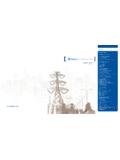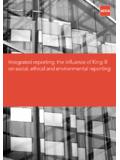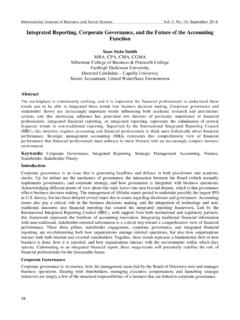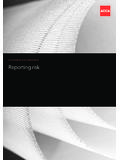Transcription of Guidance for 2006 Assessment, Listing and Reporting ...
1 July 29, 2005. MEMORANDUM. SUBJECT: Guidance for 2006 assessment , Listing and Reporting requirements pursuant to Sections 303(d), 305(b) and 314 of the Clean Water Act FROM: Diane Regas, Director /s/. Office of Wetlands, Oceans and Watersheds TO: Water Division Directors Regions 1-10. I am pleased to provide a copy of the Guidance for 2006 assessment , Listing and Reporting requirements pursuant to Sections 303(d), 305(b) and 314 of the Clean Water Act (IRG). The 2006 IRG was developed in a cooperative effort between EPA Headquarters, EPA. Regional offices, and a number of interested state partners. EPA also posted a draft version of the Guidance on its Web site for public comment between February 22, 2005 and April 22, 2005. Subsequently, EPA received approximately 40 sets of comments on the draft from a wide range of stakeholders. Those comments have been addressed in the final Guidance . This Guidance is for states, territories, authorized tribes, and interstate commissions that help states prepare and submit section 305(b) reports (hereinafter referred to as jurisdictions ).
2 It outlines development of their biennial Integrated Reports (IR) in support of EPA's strategy for achieving a broad-scale inventory of water quality conditions. The objective of this document is to provide jurisdictions a recommended Reporting format and suggested content to be used in developing a single document that integrates the Reporting requirements of the Clean Water Act (CWA) section 303(d), section 305(b), and section 314 ( pursuant to the CWA, jurisdictions report to EPA biannually on the condition of waters within their boundaries). Each IR will report on the water quality standards attainment status of all waters, document the availability of data and information for each water, identify certain trends in water quality conditions, and provide information to managers in setting priorities for future actions to protect and restore the health of our nation's aquatic resources. As stated in its introduction, the 2006 IRG is a comprehensive compilation of relevant Guidance EPA has issued to date regarding IR; however, there are few changes from the 2004.
3 Guidance . The 2006 IRG provides: (1) increased emphasis on the use of the assessment Database (ADB) or comparable electronic data format (the ADB is being modified to accommodate the recent format, content, and multi-category Listing option that the Guidance suggests), (2) greater clarity on the content and the format of those components of the IR that are recommended and required under CWA sections 303(d), 305(b), and 314, (3) greater clarity on issues associated with data solicitation, collection, consideration, and interpretation of water quality standards, (4) additional information on the option to report water quality status of individual segments in more than one category ( , to show that some designated uses of a water are being attained and some designated uses are not), and (5) additional clarity and flexibility on alternatives to total maximum daily loads (TMDLs) for attaining water quality standards ( , utilization of Reporting Category 4b ).
4 Thank you for all of your help and input in the development of this 2006 IRG. The document may be found on our Web site at: Should you have questions about the Guidance , please contact Sarah Furtak at 202-566-1167. Guidance for 2006 assessment , Listing and Reporting requirements pursuant to Sections 303(d), 305(b) and 314 of the Clean Water Act July 29, 2005. Watershed Branch assessment and Watershed Protection Division Office of Wetland, Oceans and Watersheds Office of Water United States Environmental Protection Agency This document provides EPA's Guidance for preparing the 2006 Integrated Report. The Integrated Report is intended to satisfy the Listing requirements of sections 305(b) and 314 of the Clean Water Act (CWA). This Guidance document discusses existing requirements of the CWA. and EPA's implementing regulations. Those statutory and regulatory provisions contain legally binding requirements .
5 This document describes those requirements ; it does not substitute for them. The recommendations in this document are not binding; indeed, there may be other approaches that would be appropriate in particular circumstances. When EPA makes a decision on a state's section 303(d) list, it will make each decision on a case-by-case basis and will be guided by the applicable requirements of the CWA and implementing regulations, taking into account comments and information presented at that time by interested persons regarding the appropriateness of applying these recommendations to the particular situation. CONTENTS. Section Page ABBREVIATIONS AND ACRONYMS .. v I. INTRODUCTION .. 6. II Reporting requirements UNDER THE CLEAN WATER ACT SECTIONS 303(D), 305(B), 314 AND. CORRESPONDING REGULATIONS .. 9. III. RECOMMENDED ORGANIZATION OF AN INTEGRATED REPORT .. 13. EXECUTIVE SUMMARY .. 14. PART A. INTRODUCTION.
6 14. PART B. BACKGROUND INFORMATION .. 14. PART C SURFACE WATER MONITORING AND assessment .. 17. PART D. GROUND WATER MONITORING AND assessment .. 25. PART E. PUBLIC PARTICIPATION .. 25. IV. ISSUES CONCERNING THE DEVELOPMENT AND USE OF AN assessment METHODOLOGY .. 29. V. FIVE-PART CATEGORIZATION OF WATERS .. 46. VI. Reporting RESULTS .. 65. GLOSSARY .. 66. APPENDIX: DATA ELEMENTS FOR 2006 INTEGRATED WATER QUALITY MONITORING AND assessment . REPORT AND DOCUMENTATION FOR DEFINING AND LINKING SEGMENTS TO THE NATIONAL HYDROGRAPHY. DATASET.. 70. iii TABLES. Table Page 2-1 SUMMARY OF STATE Reporting requirements UNDER CWA SECTIONS 303(D), 305(B) AND. 314 AND CORRESPONDING REGULATIONS .. 11. 3-1 ATLAS .. 15. 3-2 SIZE OF SURFACE WATERS ASSIGNED TO Reporting CATEGORIES .. 19. 3-3 ATTAINMENT RESULTS CALCULATED USING PROBABILISTIC MONITORING DESIGNS .. 20. 3-4 SEGMENT/POLLUTANT COMBINATIONS REMOVED FROM STATE'S YEAR 2004 SECTION 303(D) LIST.
7 21. 3-5 TMDL DEVELOPMENT STATUS .. 21. 3-6 INDIVIDUAL DESIGNATED USE SUPPORT SUMMARY .. 22. 3-7 SIZE OF WATERS IMPAIRED BY CAUSES .. 22. 3-8 SIZE OF WATERS IMPAIRED BY SOURCES .. 23. 3-9 TROPHIC STATUS OF SIGNIFICANT PUBLICLY OWNED LAKES .. 24. 3-10 TRENDS IN LAKE WATER QUALITY .. 24. 3-11 SUMMARY OF WATER QUALITY Reporting ELEMENTS OF AN INTEGRATED REPORT .. 27. 5-1 RECOMMENDED WATER QUALITY INDICATORS FOR GENERAL DESIGNATED USE CATEGORIES . 52. 5-2 DOCUMENTATION OF GOOD CAUSE TO MOVE SEGMENTS FROM CATEGORY 5.. 58. FIGURES. Figure Page 4-1 USING MULTIPLE TYPES OF DATA TO ASSESS ATTAINMENT .. 45. EXHIBITS. Exhibit Page 3-1 RECOMMENDED ORGANIZATION FOR YEAR 2006 INTEGRATED REPORT SUBMITTALS .. 13. 5-1 2006 INTEGRATED Reporting Guidance : SEGMENT CATEGORIZATION GUIDE .. 48. iv ABBREVIATIONS AND ACRONYMS. ADB assessment Database AU assessment Unit CALM Consolidated assessment and Listing Methodology CPP Continuing Planning Process CFR Code of Federal Regulations CWA Clean Water Act DQO Data Quality Objectives DU Designated Use EPA Environmental Protection Agency FDA Food and Drug Administration FGDC Federal Geographic Data Committee GPRA Government Performance Report Act IR Integrated Report NHD National Hydrography Dataset NOAA National Oceanic and Atmospheric Administration NPDES National Pollutant Discharge Elimination System NSSP National Shellfish Sanitation Program OW Office of Water PPG Performance Partnership Grant PWS Public Water Supply QAPP Quality Assurance Project Plan QA/QC Quality Assurance/Quality Control RIT Reach Indexing Tool SDWA Safe Drinking Water Act STORET STORage and RETrieval TMDL Total Maximum Daily Load USDA United States Department of Agriculture USFWS United
8 States Fish and Wildlife Service USGS United States Geological Survey WQC Water Quality Criteria WQS Water Quality Standard v 2006 IR Guidance I. INTRODUCTION. The Guidance for 2006 assessment , Listing and Reporting requirements pursuant to Sections 303(d), 305(b) and 314 of the Clean Water Act was developed specifically for the 2006 Reporting cycle. The objective of this document is to provide to states, territories, authorized tribes, and interstate commissions1 a recommended Reporting format and a suggested content to be used in developing a single document that integrates the Reporting requirements of the Clean Water Act (CWA) section 303(d) and section 305(b). This Guidance for developing the Integrated Report (IR) supports the Environmental Protection Agency's (EPA) strategy for achieving a broad-scale, national inventory of water quality conditions. Use of the IR format will serve to report on water quality standards (WQS) attainment status of assessed waters, document availability of data and information for each segment, identify trends in water quality conditions, and provide information to managers in setting priorities for future actions to protect and restore the health of our nation's aquatic resources.
9 EPA has established a goal that all fifty-six states and territories utilize the integrated Reporting format by 2008. EPA continues to promote this comprehensive assessment approach in order to enhance the states' ability to track both programmatic and environmental goals of the CWA, and ideally, to increase the pace of achieving these important environmental goals. This document includes recommendations designed to allow states and other interested stakeholders to track the progress of interim management actions by employing the multi-category Reporting framework. By issuing this Guidance well in advance of the April 1, 2006 deadline for submission of CWA section 303(d) lists and section 305(b) reports, EPA intends to encourage the broadest possible adoption of the integrated Reporting approach. EPA continues to advocate the use of the five-part categorization format for sorting waters (see box below for brief description and Section V).
10 While this document is more comprehensive than previous Integrated Report Guidance , there are clarifications to the previous (2004) Integrated Report Guidance . Specifically, this Guidance provides: increased emphasis on the use of the assessment Database (ADB) or compatible electronic data format (the ADB is being modified to accommodate the recent format, content, and multi- category Listing option that the Guidance suggests), greater clarity on the content and the format of those components of the IR that are recommended and required under CWA sections 303(d), 305(b), and 314, greater clarity on issues associated with data solicitation, collection, consideration, and interpretation of water quality standards, additional information on the option to report water quality status of individual segments in more than one category ( , to show that some designated uses of a water are being attained and some designated uses are not),2 and additional clarity and flexibility on undertaking and Reporting alternatives to total maximum daily loads (TMDLs)














